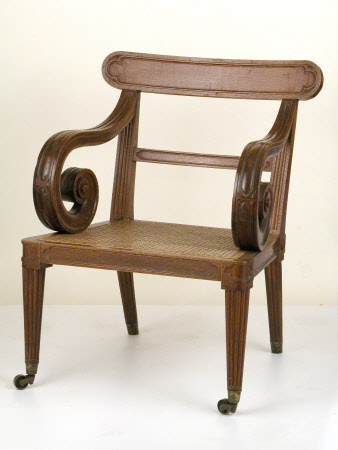The Stourhead Justice Room Armchair, 1816.
Thomas Chippendale II (1749 - 1822)
Category
Furniture
Date
1816
Materials
Oak, cane, brass
Measurements
85 x 64 x 59 cm
Place of origin
London
Order this imageCollection
Stourhead, Wiltshire
NT 731750
Summary
An oak open armchair, by Thomas Chippendale the Younger (1749-1822) London, 1816. Commissioned by Sir Richard Colt Hoare for the Justice Room at Stourhead. The rounded curved top rail with a gothic tracery panel and horizontal stretcher held by reeded back stiles. The over scrolled arms also with gothic panels joining a caned seat with conforming rails and raised on reeded turned tapered legs and brass socket castors. Originally a pair, one now missing from the collection at Stourhead.
Full description
Chippendale's account dated 23rd March 1816: '2 Large strong Oak Chairs with hollow splat backs and carved gothic panels, large carved scrowl elbows with Gothic panels, the rails to match and quilled term feet the seats cand & strong brass socket castors £16-16-' and '2 large thick bordered hair cushions to ditto stuffed in canvas & coverd with black Spanish leather and large red welts £6-10-' Thomas Chippendale the Younger at Stourhead Sir Richard Colt Hoare employed Thomas Chippendale the Younger (1749-1822) from 1795 to 1820 to supply furniture and furnishings for Stourhead in Wiltshire. The accounts submitted for his work are the largest known archive relating to Chippendale’s work. Out of the 163 pieces of furniture described in the accounts, 103 are still in the house, mostly in the rooms for which they were made. There was a fire in 1902 which destroyed the central part of Stourhead but fortunately most of the pictures and furniture from the ground floor were saved, the majority of the contents of the upper floors were destroyed. Chippendale the Younger worked with his father Thomas Chippendale (1718-1779) for many years before the latter died. Much of the work he produced in the 1780s and 1790s continued the styles and techniques associated with the Chippendale firm. During these years he was completing or continuing commissions that the firm had been involved with including Harewood house, Nostell Priory, and Burton Constable amongst others. The furniture supplied for Stourhead shows the continued high quality and attention to detail that was expected from the Chippendale workshops, linked with simplicity of decoration and clarity of line. For further discussion and extensive published research see Goodison, Judith ‘The life and work of Thomas Chippendale Junior’ PWP 2017 Goodison, Judith ‘Thomas Chippendale the Younger at Stourhead’ Furniture History Society 2005 (Vol. 41) pp. 57-116 Gilbert, Christopher ‘The life and work of Thomas Chippendale’ London 1978 Vol.1 pp.235, 267 Beard, Geoffrey & Gilbert, Christopher ‘The Dictionary of English Furniture Makers, 1660-1840’ Furniture History Society 1986 pg.169 Dudley Dodd & Lucy Wood, 'The Weeping Women commode and other Orphaned Furniture by the Chippendales at Stourhead', in Furniture History XLVII (2011) James Weedon (March 2018)
Provenance
Commissioned for the Justice Room at Stourhead by Sir Richard Colt Hoare. Made and supplied by Thomas Chippendale the Younger in 1816. Given to the National Trust along with Stourhead House, its grounds, and the rest of the contents by Sir Henry Hugh Arthur Hoare, 6th Bt (1865 – 1947) in 1946.
Makers and roles
Thomas Chippendale II (1749 - 1822), cabinetmaker
References
Goodison, 2005: Judith Goodison. “Thomas Chippendale the younger at Stourhead.” Furniture History 31 (2005): pp.57-116, pp. 57-116 Gilbert, 1978: Christopher Gilbert. The life and work of Thomas Chippendale. London: Studio Vista: Christie’s, 1978., pp. 235, 267 Beard and Gilbert, 1986: Geoffrey Beard and Christopher Gilbert (ed), Dictionary of English Furniture Makers 1660-1840, 1986, pg.169 Goodison, 2017: Judith Goodison, The Life and Work of Thomas Chippendale Junior, PWP London & New York 2017 Dodd & Wood 2011, Dudley Dodd & Lucy Wood, 'The Weeping Women commode and other Orphaned Furniture by the Chippendales at Stourhead', in Furniture History XLVII (2011)
